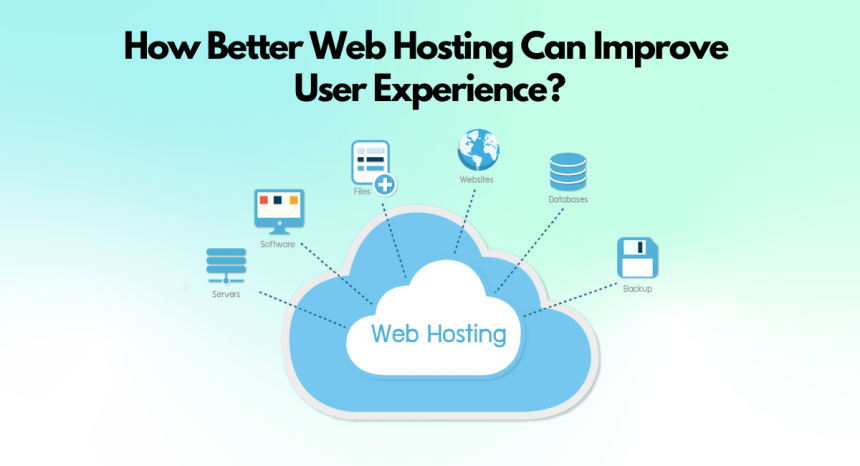Better web hosting:
can significantly improve user experience by ensuring faster load times, higher uptime, and better reliability. A reliable hosting provider minimizes downtime, providing a seamless browsing experience. Faster website speeds reduce bounce rates, while optimal server performance enhances site responsiveness. Additionally, advanced features like SSL certificates and security measures foster user trust, further improving the overall experience.
A website is more than a digital shop window, as it is the initial point of contact for many users of the business. However, many companies do not give proper attention to one of the most essential parts of such an experience: web hosting. The selection of the hosting cannot be limited to uptime guarantees or storage alone. The idea is to provide a professional, advanced, and flawless user experience design that will keep visitors engaged and transform them into customers.
In this post, we examine why and how improved web hosting enhances the user experience and why investing in quality infrastructure is worthwhile in terms of both performance and user satisfaction.
1. Faster Load Times = Better UX
User experience begins the moment someone lands on your site. According to Google, users expect a site to load in under three seconds. If it takes longer, over half will bounce. Slow sites frustrate users and damage your brand.
High-performing hosting providers offer:
- Optimized server configurations
- Advanced caching
- Content Delivery Networks (CDNs)
- SSD storage
A Website Developer opting for quality hosting does not simply spend money on speed but on ease of movement, faster checkout times, and general satisfaction.
2. Better Hosting Enables the Responsive Design
The responsive site is one that is ideally adjusted to any screen size, whether it’s a phone or a desktop. However, a fluid design would be far less smooth when your server is slow or when it is not capable of current technologies, e.g., HTTP/2 or Brotli (compression).
A quality host ensures:
- Fast rendering on mobile and tablets
- Minimal lag across devices
- Consistent performance across browsers
3. Uptime Is Trust
Nothing kills trust faster than a “This site can’t be reached” error. Registered, licensed, or certified businesses need their websites online 24/7—not just during business hours.
Reliable hosts offer:
- 99.9%+ uptime guarantees
- Redundant systems
- Proactive monitoring
If a Web Designer spends hours creating a stunning site, but it’s constantly down, the design doesn’t matter. Uptime is the foundation of a credible user experience.
4. Secure Hosting = Secure Experience
The issue of security is not negotiable. Whether it is an e-commerce site or a portfolio, users want to have their information secured. Good hosts provide SSL certificates, virus scans, firewalls, and backup programs.
This is how it affects UX/UI design:
- Users more readily recognize trustworthy sites.
- Browsers indicate to the visitor that an insecure site is not secure, thus discouraging the visitor from visiting the site.
- Smooth checkouts and form submissions result in a higher conversion rate.
5. Scalable Hosting Adapts Alongside Your Business
Still, not every place is stationary. When your traffic increases, your infrastructure must also expand. Whether you’re expanding into new services, launching a blog, or opening an online store, you should be able to scale up with your hosting provider.
Scalable hosting supports:
- Resource spikes without downtime
- Quick upgrades
- Load balancing for large user bases
Whether you’re redesigning or rolling out a significant redevelopment, scalable hosting
ensures things keep running smoothly.
6. SEO Gains = UX Wins
Fast, secure, and mobile-optimized websites rise to the top of search engines. That means better hosting directly boosts SEO rankings.
Higher rankings mean:
- More traffic
- Lower bounce rates
- Increased engagement
Great hosting doesn’t just make things easier for users—it makes it easier for them to find you. A qualified web Developer understands that backend choices, such as hosting, influence frontend visibility.
7. Hosting Powers Creative Features
Would you like to incorporate video backgrounds, interactive galleries, or live chat? These all need server resources. Weak hosting can lead to crashes or features that fail to load.
High-end hosting unlocks the freedom to build a more innovative experience:
- Host large media files with no lag
- Handle AJAX requests for smooth interactivity
- Serve dynamic content based on user behavior
When your host can keep up, your design vision becomes a reality—not a compromise.
8. Better Hosting Improves Developer Workflow
For Developers, smooth backend environments mean better productivity. Quality hosting platforms offer:
- Staging environments
- Git integration
- One-click deployments
- Robust APIs
9. Cost vs. Value: Why Cheap Hosting Hurts UX
Many businesses attempt to cut corners with inexpensive hosting, believing they’re saving money. However, the expense of poor hosting adds up quickly, resulting in lost sales, decreased SEO, and frustrated users.
Better hosting provides:
- Proactive customer support
- Better performance
- Fewer outages
10. Hosting Supports Long-Term Maintenance
Websites aren’t one-and-done. They require ongoing care, including updates, bug fixes, and optimizations. A good host makes upkeeping easier with the following:
- Automated backups
- Easy rollback options
Specialists know that smooth site management yields a better experience for both administrators and users.
11. Different Types of Hosting = Different Levels of UX
Hosting isn’t one-size-fits-all. The sorts of hosting include:
- Shared hosting: Budget-friendly but limited
- VPS hosting: More resources, more control
- Dedicated hosting: Full server access
- Cloud hosting: Scalable and redundant
Choosing the right type is critical. Experienced developers will select a hosting solution that matches the project’s complexity and target audience. The wrong kind can cause downtime, speed issues, or limit growth.
12. Experts Know Hosting Is UX Infrastructure
Nowadays, UX and UI design go beyond colors and layout. It is closely related to the performance, security, and reliability of things fueled by hosting.
No design can rescue your site when it crashes during a product launch or is unable to support mobile traffic. Every successful site is based on better hosting.
14. Hosting Influences Customisation Potential
From user dashboards to real-time personalization, customized websites need power behind them. Hosting affects how far developers can push personalization without compromising the site’s performance.
A licensed developer working on an e-learning platform may need advanced PHP versions, scalable databases, or specific memory limits. Without the right host, that customization is either expensive—or impossible.
15. Productivity: Hosting as an Enabler
Lastly, better hosting enables your entire team to be more productive. Marketers get faster page updates. Designers see their animations load correctly. Developers push updates without server errors. Support teams face fewer complaints.
All of this creates a more agile and confident environment where the team can focus on building better experiences rather than patching hosting issues.
Final Word
Great user experience doesn’t start on the page—it begins on the server. From performance and security to scalability and uptime, better web hosting is the unsung hero of effective website design and functionality.
FAQs:
1. What is Web hosting, and why is it essential to user experience?
Web hosting is a service that stores files for your site and makes them available on the Internet. Excellent hosting will mean your site is not only quick to load but also remains safe and accessible to users at all times, which will directly influence how users perceive the site.
2. What is the importance of hosting on-site speed?
Hosting defines the speed at which your server can provide content. Good servers implement SSDs, an optimized stack, and a CDN to deliver pages more quickly. This implies more straightforward navigation, reduced bounce rates, and improved SEO — all of which are significant components of the user experience.
3. Is shared hosting harmful to user experience?
It is not always the case, but there are limitations to it. Shared hosting implies that your site shares resources with others and can be impacted during peak hours. VPS or cloud hosting are better options for larger or growing sites.







